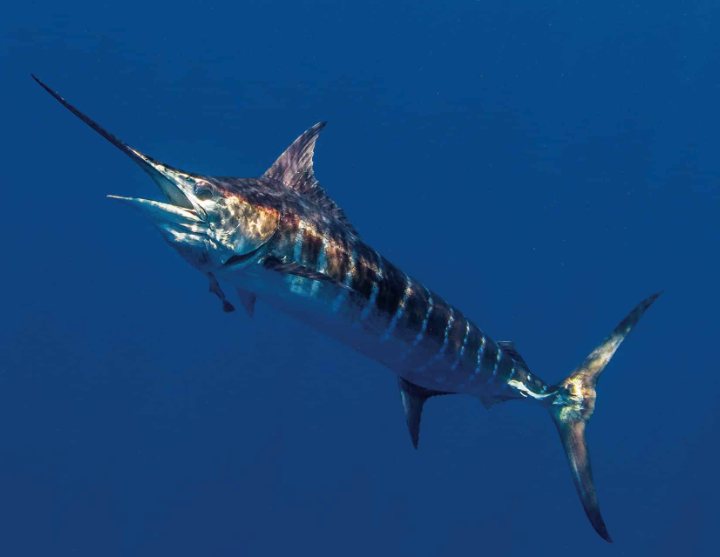Marlin are part of the billfish family, Istiophorids, and are commonly found in tropical and subtropical waters across the world. Billfish are a group of predatory saltwater fish, known to be one of the fastest swimmers in the ocean. They are mostly characterized by their prominent pointed noses or bills. Due to their strength and the acrobatic show they put on when hooked, marlin have become one of the most sought-after bucket-list catch for many anglers.
Different species of marlin
There are 4 different species of marlin: the black marlin, blue marlin, striped marlin and white marlins. Although they look pretty similar, they each have their own characterisitcs and habitats.
Black Marlin (Istiompax indica)
- Appearance: it has a dark blue-black color above and lighter belly. It does not have any vertical stripes. Their pectoral fins are rigid, which means they can’t fold them along their body like blue or striped marlin can. Black marlin can grow up to 15 ft long.
- Weight: typically between 400 to 1,000 pounds, but can be up to 1,500 pounds.
- Where: tropical and subtropical waters of the Pacific and Indian Ocean. Open waters from Chile up through southern California. Popular fishing spots are Australia (notably Cairns), Hawaii (Kona), Mexico, Panama and Costa Rica.
- IGFA ALL-TACKLE WORLD RECORD: Alfred Glassell Jr – 1,560 pound black marlin – 4 August 1953 in Cabo Blanco, Peru

Blue Marlin (Makaira nigricans)
- Appearance: deep royal blue and green tones with a paler belly, sometimes with pale vertical bars on its sides. Blue marlin can grow up to 15 ft long.
- Weight: typically between 200 and 400 pounds, but can be up to 1,000 pounds.
- Where: tropical and subtropical waters of the Indian, Pacific and Atlantic Oceans. Found worldwide.In the Atlantic, popular spots include Ghana, Cape Verde, Canary Islands, Madeira, Azores, Portugal and fishing in Punta Cana and the Caribbean in general. In the Pacific, popular spots are Hawaii, Mexico (notably Cabo San Lucas), Panama, Costa Rica, and Guatemala. Australia also has some of the best blue marlin fishing in the world.
- IGFA ALL-TACKLE WORLD RECORD: Jay de Beaubien – 1,376 pound Pacific blue marlin – 31 May 1982, off Kaaiwi Point, Kona, Hawaii

Striped Marlin (Kajikia audax)
- Appearance: blue tones above and white below, with pale vertical bars on its sides. Its pelvic fins are much longer than its pectoral fins, and have a relatively high dorsal fin vs its cousins. Striped marlin can grow up to 12 ft long.
- Weight: does not typically exceed 275 pounds.
- Where: tropical and subtropical waters of the Pacific and Indian Oceans. Oregon through Chile. Though it lives in open waters, they can sometimes be found inshore.
- IGFA ALL-TACKLE WORLD RECORD: Bill Boniface – 494 pound striped marlin -16 January 1986, off the Tutukaka coast, New Zealand
White Marlin (K. albida, or K. albidus)
- Appearance: blue and green tones with a paler belly, with pale vertical bars on its sides. White marlin can grow up to 9 ft long.
- Weight: does not typically exceed 100 pounds.
- Where: tropical waters of the Eastern Atlantic Oceans. From south of Portugal to the southwestern Mediterranean, and in the western Atlantic from Nova Scotia south to Brazil. It has also been found in the Gulf of Mexico and the Caribbean.

How to Catch a marlin
Marlin come up to the surface to feed off smaller predatory fish such as squid and baitfish. The most successful way to catch in a marlin is to troll. Trolling is a fishing technique where the boat tows a line or lines with bait or artificial lures at a consistent and slow speed. Marlins tend to respond well to whole bait such as bonito, mackerel, mullet or squid. Artificial baits can also work, but its best to use baits that resemble a big bait fish or big squid lures. Trailing these appropriate bait of approximately 1-2 foot in size, will entice the marlin to come near the boat. Circle hooks should be used as marlin have tough mouths which are very difficult to hook in.
Book a Marlin All-Inclusive Fishing Trip
If you are looking for a unique place to hook a marlin, an all-inclusive fishing trip in Panama is the way to go. Come visit us between the months of December and February and our captains will take you to Hannibal Bank or Isla Montuosa so you can check out the action for yourself. Check out our fishing packages or send us an inquiry at panamanauticalclub@gmail.com.







